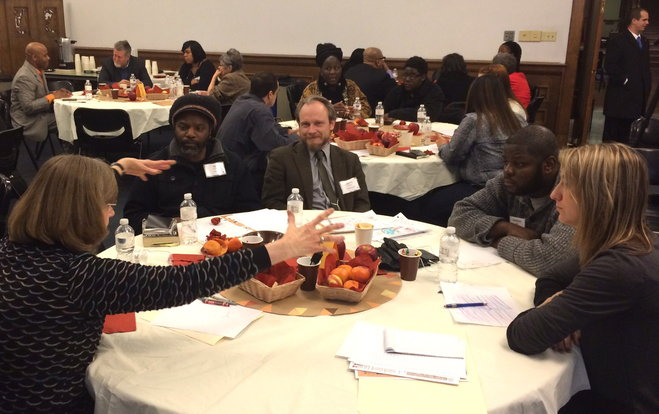A Frank Talk About Race
Share
Explore Our Galleries
Breaking News!
Today's news and culture by Black and other reporters in the Black and mainstream media.
Ways to Support ABHM?
By James E. Causey, Milwaukee Journal Sentinel
A wonderful thing happened at the 100th birthday celebration for the founder of America’s Black Holocaust Museum — dozens of people from all colors and backgrounds sat at tables to discuss race relations in this city. (…)
Last Sunday, about 150 people gathered at the Milwaukee Public Library to honor Cameron. U.S. Rep. Gwen Moore and Milwaukee Ald. Milele Coggs told personal stories of Cameron; and Robert Smith, a history professor at the University of Wisconsin-Milwaukee, explained how Cameron became a civil rights leader.[Editor’s Note: Sharon Morgan and Tom DeWolf, nationally known for their book, Gather at the Table: The Healing Journey of a Daughter of Slavery and the Son of the Slave Trade, spoke of the challenges they faced in their own racial reconciliation journey.] (…)
There is still a lot of pain and emotion that surrounds the hot button topic of race relations in this country.
Let’s face it, we all have opinions and stereotypes that we harbor about those who are different from us, but the worst thing that can happen is when we have a breakdown in talks or we wait until something like the Trayvon Martin case comes to light to talk about how a certain group of people are viewed.

Jan Buchler, who recently retired as the director of a community-based organization, served as a facilitator of one of the diverse dialog groups at the 100th Birthday Celebration for Dr. James Cameron: A Gathering for Racial Repair and Reconciliation. (James Causey, Milwaukee Journal Sentinel)
Last Sunday, dozens of people participated in the exercise. The tables were diverse and table captains made sure no one dominated the conversation or interrupted the person talking.
Groups tackled several questions such as: “What might the process of racial repair and reconciliation look like in Milwaukee?” “Why is it difficult for us to have conversations about race?” and “Do we need a safe place to have these conversations?”
The exercise also gave participants the opportunity to sketch out what racial repair looks like with crayons. No one at my table had a hard time with this part of the exercise, and most of us came up with the same conclusion: We are a divided city, and in order for major changes to occur, our neighborhoods, circle of friends and places of employment need to become more diverse.(…)
Theresa, who was at my table, said people just need to start talking to each other. Theresa who is black, moved to Brown Deer in 1983, but she said she still has neighbors who refuse to speak.
“We just have to be more willing to talk to people who are different than us,” she said. “I guess that I should start doing that, too.”
Jenna, who is white, said the topic of race is avoided so much that she is clueless as to how to even start such a conversation.
“I really don’t get it because it’s on everyone’s mind, but we can’t talk about it outside of our friends and people we know and love,” she said. “I’m in school and the conversation is avoided. If it’s not talked about at school, work or in our communities, when can we talk about it?”
Read the full article and view Causey’s video interview with Jan Buchler here.
Find more breaking news here.











Comments Are Welcome
Note: We moderate submissions in order to create a space for meaningful dialogue, a space where museum visitors – adults and youth –– can exchange informed, thoughtful, and relevant comments that add value to our exhibits.
Racial slurs, personal attacks, obscenity, profanity, and SHOUTING do not meet the above standard. Such comments are posted in the exhibit Hateful Speech. Commercial promotions, impersonations, and incoherent comments likewise fail to meet our goals, so will not be posted. Submissions longer than 120 words will be shortened.
See our full Comments Policy here.